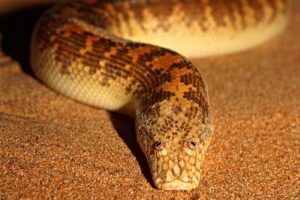Wearing a mask, a large hat and wearing blue rubber gloves, paleontologist Evan Saitta looks more like a person on a shopping trip during the Covid epidemic than a scientist on a research field.
But it is located in the Dinosaur Provincial Park in Canada. The place is known for dinosaur fossils and it is because of them that Saitta is wearing a quarantine suit.
He is not afraid of contracting a disease, but the costume is meant to protect the bone remains and prevent any of his own genetic material from getting on the bone. Namely, he is looking for genetic material that could be hidden in this bone.
The purpose is to settle somewhat heated disputes between scientists. On one side are scientists who in recent years believe they have discovered remarkable dinosaur bones with remains of soft tissue: blood vessels, cells, proteins and even DNA.
However, other scientists point out that these incredible discoveries have not been sufficiently investigated by independent scientists and consider it improbable that fragile molecules can be preserved in the earth for many millions of years.
Evan Saitta is an expert on tissue decomposition and the origin of fossils, and leans towards the latter view. But he is not satisfied with just words, but now intends to force a result and has therefore come here in search of genetic material.
When he returns home to the lab, he uses every conceivable state-of-the-art technology in the fields of electron microscopes and gene assembly tools.
He even dissects the remains of dead sand lizards and birds to gain a better insight into what happens to the body’s molecules.
The stakes are high, both for Saitta and the rest of us who are interested, because if it turns out that petrified bone can actually harbor millions of years of genetic material, it will breathe new life into a dream that scientists had long since given up on. : bringing the dinosaurs back to life.
A dinosaur from a midge’s stomach
In the movie Jurassic Park, a scientist drills a hole in a block of electricity to get to a vole that had ended its life there. From the fly’s stomach he carefully sucks its last meal – dinosaur blood full of genetic material.
It is true that the genetic material turns out to be holey, but the holes can be filled with genetic material from frogs, and after the genome is placed in an egg, it hatches into an authentic baby dinosaur.
When the film was released in 1993, this remarkable methodology seemed, roughly speaking, not far from being able to pass.
Scientists had just found DNA in insects in electric blocks, and a new method for sequencing genetic material based on DNA fragments had been invented.
But later these discoveries were criticized on the basis that modern DNA had contaminated what was found and the method behind the discovery was considered flawed. Since then, numerous studies have cast doubt on the fact that DNA can in any way survive for millions of years.
How can dinosaurs be revived?
Drilling machines, DNA printing and artificial eggs – the technology exists and if it turns out that DNA can be extracted from dinosaur bones, the recipe is usable. And then maybe one day scientists will be able to revive dinosaurs.
In 2013, for example, British researchers studied insects in copal, which is a kind of intermediate between resin and electricity. The insects were between 60 and 10,600 years old and the scientists found no trace of genetic material in them.
No traces of such old DNA have been found in fossils either. The oldest complete genome ever found was in a 700,000-year-old horse bone preserved in permafrost.
In 2012, a group of Danish and Australian scientists tried to find the longest possible lifetime of genetic material. The state of genetic material in the bones of the extinct Moaful was studied and how genetic material breaks down over a long period of time was calculated.
The result was that genetic material has completely disappeared from the bone remains after 1.5 million years.
The proto-needles, with the exception of the birds, all died out 66 million years ago, so the lifespan of genetic material in their fossils must have long passed.
Proteins also store genetic information as their structure mirrors the genetic code.
They last longer than DNA, but the oldest proteins the scientists found were 3.4 million years old, so the problem was not solved.
Nevertheless, people have increasingly searched for old DNA, proteins or soft tissue in recent decades, and Montana in the northwestern part of the USA is now a kind of center of this new molecular paleontology.
In the Museum of the Rockies, paleontologist Jack Horner, who was a scientific consultant for the making of the Jurassic Park movies, had his studio.
He is now retired, but his former students are heavily involved in the debate over the potential for DNA to survive in fossils.
DNA in baby lizards
Among Jack Horner’s former students is molecular paleontologist Mary Schweitzer. Along with other researchers, she has in recent years described some controversial findings that suggest soft tissue can be found in well-preserved fossil bones.
Together with another old student of Horner, Alida Bailleul, she made another new discovery in 2020 .
In two pre-echinoderm fossils in Montana, they claim to have discovered the protein collagen in a tissue that looks like cartilage.
They have also found microscopic features that could be cells in the process of dividing, as well as elongated features that could possibly be cell nuclei – with DNA.
This was found in two skulls of young platypuses that lived in Montana 75 million years ago, but Jack Horner was among those who found the skulls in 1979, when he discovered an entire nest site, known as “Montana’s Egg Mountain”.
Five dinosaur encounters surprise scientists
DNA, cells and proteins. Scientists say they have found remnants of original tissue in five different dinosaurs – including the king of the dinosaurs, T. rex. The most recent discovery – DNA from the predatory lizard Caudipteryx – was made in 2021.
The skulls were cut into thin slices and preserved that way, but now, as they say, new discoveries have been made in these old slices.
The scientists have compared the skulls of the chicks and a skull of a young emu, and certain tests were performed on both the old skull and the new one.
The samples were first placed in an acid bath that dissolved all inorganic material, but then the researchers added to the solution so-called antibodies that the immune system usually forms in the fight against bacteria and viruses.
There are an infinite number of types of antibodies, and each type has the ability to bind only – or almost only – to one specific type of protein.
Therefore, antibodies are used in research to determine whether a particular protein is present in a sample.
In the samples analyzed by Mary Schweitzer, the antibodies showed traces of a certain type of collagen from cartilage in both the emu and the fossils.
Now the researchers believe that there was cartilage in the back of the skull in the baby lizards, where the bone parts would have grown together.
If cartilage is preserved, the probability of DNA preservation increases because cartilage is not as porous as bone and could therefore form a stronger DNA storage.
Scientists debate about DNA
Controversial discoveries of DNA, proteins and cells in millions of years old fossilized remains have sent tremors through the scientific world. New research shows that these discoveries are probably something completely different than first thought.
Protein
With: Bones full of proteins
Antibodies directed at collagen proteins bind to the pre-echinoderm, and since bacteria do not produce collagen, the proteins must come from the animal itself.
At the tournament: Tests give wrong answers
The antibody method is unreliable because the antibodies can also bind to minerals such as calcium phosphate. Remnants of collagen can also come from microscopic fungi.
Blood vessels and cells
With: Blood cells have survived
Several independent studies under the electron microscope show that the fossils contain phenomena reminiscent of blood vessels, red blood cells and bone cells.
Opposite: Vacuum shows cells
Bacteria can leave behind remnants that look like blood vessels, and clumps that look like cells can be side effects of vacuuming under an electron microscope.
DNA
By: Bones can preserve DNA
A dye that binds to DNA accumulates in cell-like clumps in the bone. The discovery is remarkable, but DNA research has been surprising before.
Against: DNA comes from microbes
Analyzes of DNA in other fossils show that DNA breaks down within a few million years. Residues of DNA from lizards are false positives or DNA from microbes.
How long can dinosaur DNA survive?
The scientists also looked for DNA in the emu’s cells and cell-like parts of the fossils.
This test involved adding a dye that binds to DNA, and this was the case in both the emu and lizard remains. This suggests that DNA – or fragments of DNA – can be preserved in bones for up to 75 million years.
Schweitzer and her colleagues are not entirely alone in this theory. In this way, English scientists claim to have found the remains of cartilage fibers and blood cells in quite a few fossil bones.
In contrast to other such discoveries, these were bones that had not been preserved particularly well.
Therefore, the English scientists believe that not only can DNA be preserved, but it also happens more often than anyone has dared to hope.
It was not least this claim that prompted Evan Saitta to put on his quarantine overalls and begin his search for DNA and proteins in Canada’s Pre-Needle National Park.
The bones were a surprise
Saitta first collected fossil samples under sterile conditions to avoid contaminating the bones during excavation. The bones were about 75 million years old and from a lizard related to the three-horned Triceratops.
The samples were sent to the research institutes at Princeton University in the USA and the University of Bristol and York in England, where they were analyzed using various different methods to reduce possible result errors and misinterpretations.
However, they were not tested with antibodies, as Mary Schweitzer did, as that method is believed to give a false positive response.
The results were the same in all cases. The samples were uncontaminated and no traces of collagen were found. On the other hand, there was something else that took people by surprise. A lot of DNA was found in the bones – but not from pre-needles.
The genetic material came from a large number of microbes that had taken up residence in the bones. In total, Saitta and his colleagues found 46 species of bacteria and other microorganisms, including a number of previously unknown species.
Some of the microbes were able to break down collagen.
“The project shows that bones are not particularly well suited to preserving soft tissue. They are not time capsules, but porous and open systems where organic matter has an easy way out into the soil and microbes can easily enter,” says Evan Saitta.
He believes that the remnants of DNA that other scientists have found come from microbes, and that the collagen-like proteins may be made by fungi. The parts that resemble blood vessels, cell nuclei and cells are probably also formed by the microbes.
Pressure welding creates fossils
Researching the fossils from the Canadian desert is only a small part of Evans Saitta’s work. He also uses completely different methods – some based on great sensitivity – to study whether ancient fossils can preserve original molecules.
After death, an animal must first bury itself in sand, for example, to be able to turn into a fossil over time. Over millions of years, the carcass is buried so deeply that its remains are exposed to tremendous pressure and extremely high temperatures. Saitta tries to reproduce this process in a laboratory.
Robots bring the past to life
Genetically modified chickens, brains and holograms – cloning is not the only way to create dinosaurs. Advances in genetic engineering and engineering may also make that dream a reality.
Reverse evolution turns a chicken into a dinosaur
Birds are descended from pre-needles and still carry remnants of their genetic material. Paleontologist Jack Horner wants to use these remains to reverse the evolution of birds. He is trying to use the CRISPR technology to change the genome of chickens so that they more closely resemble these ancestors. However, this has not yet been successful.
Robots move like dinosaurs
In museums and amusement parks you can often see mechanical dinosaurs, but they are usually clunky and rarely scientifically built. New artificial intelligence technology is now being used to make the movements more natural, and in recent years paleontologists have contributed with detailed reproductions based on bones and footprints.
Holograms make animals soar
A moving pre-needle is projected as a moving 3D hologram. Hologram technology is still far from perfect, but progress is being made quickly. In one experiment, a lighted plastic bead was blown rapidly but purposefully with air waves so that it drew a three-dimensional image of a butterfly in flight.
Previous experiments have been based on placing organic matter under very high pressure and heat in a closed and airtight space. But under these conditions, the materials that under natural conditions would evaporate or seep into the soil have no escape route and therefore remain in a continuous sticky mass at the bottom of the closed space.
Saitta and his collaborator Tom Kaye have therefore developed another method. They pack parts of a dead sand lizard or chicken in clay that is placed in a steel case, where a bulldozer is used to compress the material with hydraulic pump pressure of many tons.
The result will be a pressed plate about 1.25 cm thick and it is then placed in an oven at 200 degrees for 24 hours. The clay is porous enough to allow unstable molecules to escape.
With this method, the artificial fossils will be very similar in taste to those found in nature.
The first results of these experiments indicate that only bone remains and the pigment melanin will remain.
Almost everything else, including melanin, is lost. The experiments seem to prove that the pigment is among the very few types of biomolecules that can survive for millions of years.
However, the debate about DNA and proteins in fossils is far from over. They have now resurfaced, thanks to Mary Schweitzer and her latest discoveries in Montana.
But Saitta now intends to focus on the search for more stable biomolecules, for example amino acids, which are the smallest units of proteins.
That search may not raise any hopes of cloned dinosaurs, but the amino acids are more long-lived than proteins or DNA – and can provide some insight into the biology of the ancient creatures.
New research suggests that electricity – just like in Jurassic Park – can preserve certain types of molecules for millions of years.
Saitta, however, looks in a completely different direction – at the egg of the eel. “The eggshell is interesting because, unlike bone, it can act as a closed system.
“You could possibly find short pieces of amino acids there that would have been preserved for millions of years,” says Saitta.
And that theory has actually been proven. Earlier in 2020, Saitta found traces of ancient amino acids in an 80-million-year-old egg of a long-necked lizard.
























